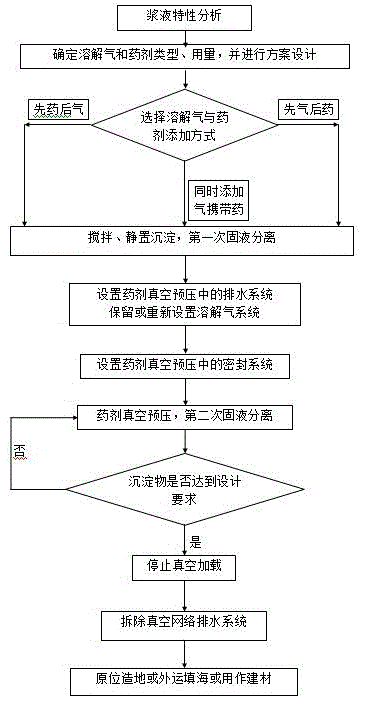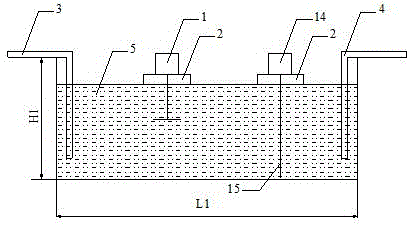Dissolved gas and reagent integrated vacuum preloading method
A vacuum pre-pressing method, dissolved gas technology, applied in chemical instruments and methods, dewatering/drying/concentrated sludge treatment, water/sludge/sewage treatment, etc., can solve the problem of reducing permeability coefficient, affecting treatment effect and cost problems such as high cost, to achieve the effect of increasing the permeability coefficient, improving the treatment effect, and increasing the living space
- Summary
- Abstract
- Description
- Claims
- Application Information
AI Technical Summary
Problems solved by technology
Method used
Image
Examples
Embodiment 1
[0033] The dissolved gas-pharmaceutical vacuum preloading method of the present invention comprises the following steps:
[0034] (1) Take engineering waste slurry samples on site, and measure and analyze their special physical and chemical properties such as moisture content, particle composition, mineral composition, PH value, and specific gravity.
[0035] (2) Determine the addition amount and parameters of the first chemical agent A, the second chemical agent B, the third chemical agent C, and the dissolved gas D according to the analysis results of step (1), the first chemical agent A, the second chemical agent B. The mixing ratio of the third chemical agent C is about 0.01%~0.6%, 0.05%~0.4%, 0.001%~0.1%, respectively, the pressure of the dissolved gas D is 0~0.6MPa, and the temperature is 0~60 degrees. For example, the mixing ratios of the first chemical agent A, the second chemical agent B, and the third chemical agent C in Embodiment 1 are about 0.3%, 0.2%, and 0.05%, ...
Embodiment 2
[0050] Embodiment 2 is basically the same as Embodiment 1, except that the mixing ratios of the first chemical agent A, the second chemical agent B, and the third chemical agent C are about 0.01%, 0.05%, and 0.001%, respectively.
Embodiment 3
[0052] Embodiment 3 is basically the same as Embodiment 1, except that the mixing ratios of the first chemical agent A, the second chemical agent B, and the third chemical agent C are about 0.6%, 0.4%, and 0.1%, respectively.
[0053] The above construction process is a routine procedure for solid-liquid separation of dissolved gas-pharmaceutical vacuum preloading method. When dissolved gas is used as the carrying medium, steps 3 and 4 in the specific implementation steps can be combined into: through the gas according to the determined parameters The first chemical agent A, the second chemical agent B, and the third chemical agent C are injected into the waste slurry. When it is necessary to add dissolved gas during the vacuum preloading process, step 4 can be moved to after step 8, and the dissolved gas can be continuously or intermittently injected during the vacuum preloading process as required.
[0054] During specific implementation, the type, pressure, and temperature ...
PUM
 Login to View More
Login to View More Abstract
Description
Claims
Application Information
 Login to View More
Login to View More - R&D
- Intellectual Property
- Life Sciences
- Materials
- Tech Scout
- Unparalleled Data Quality
- Higher Quality Content
- 60% Fewer Hallucinations
Browse by: Latest US Patents, China's latest patents, Technical Efficacy Thesaurus, Application Domain, Technology Topic, Popular Technical Reports.
© 2025 PatSnap. All rights reserved.Legal|Privacy policy|Modern Slavery Act Transparency Statement|Sitemap|About US| Contact US: help@patsnap.com



